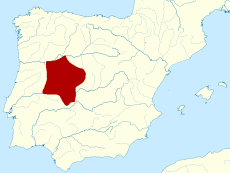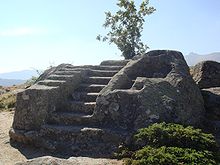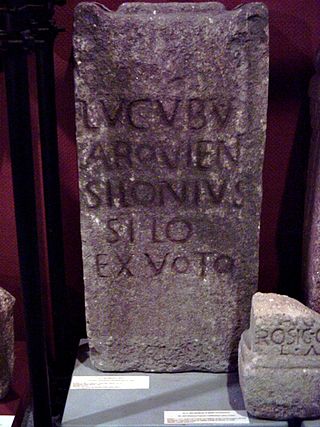

The Vettones (Greek: Ouettones) were an Iron Age pre-Roman people of the Iberian Peninsula. [1] [2]


The Vettones (Greek: Ouettones) were an Iron Age pre-Roman people of the Iberian Peninsula. [1] [2]
Lujan (2007) concludes that some of the names of the Vettones show clearly western Hispano-Celtic features. [3] A Celtiberian origin has also been claimed. [1] Organized since the 3rd Century BC, the Vettones formed a tribal confederacy of undetermined strength. Even though their tribes' names are obscure, the study of local epigraphic evidence has identified the Calontienses, Coerenses, Caluri, Bletonesii [4] [5] and Seanoci, [6] but the others remain unknown.

A predominately horse- [7] and cattle-herder people that practiced transhumance, archeology has identified them with the local 2nd Iron Age ‘Cogotas II’ Culture, also known as the ‘Culture of the Verracos’ ( verracos de piedra ), named after the crude granite sculptures representing pigs, wild boars and bulls that still dot their former region. These are one of their most notable enduring legacies today, the other possibly being the game of Calva, which dates to the time of their influence. The Iron Age sites and respective cemeteries of Las Cogotas, La Osera, El Raso de Candeleda, La Mesa de Miranda, Yecla la Vieja, El Castillo, Las Merchanas and Alcántara have provided enough elements – weapons, shields, fibulae, belt buckles, bronze cauldrons, Campanian and Greek pottery – which attest the strong contacts with the Pellendones of the eastern meseta, the Iberian south and the Mediterranean.

The Vettones lived in the western part of the meseta —the high central upland plain of the Iberian Peninsula —the region where the modern Spanish provinces of Ávila and Salamanca are today, as well as parts of Zamora, Toledo, Cáceres and also the eastern border areas of modern Portuguese territory. Their own capital city, which the ancient sources mysteriously failed to mention at all, has not yet been found though other towns mentioned by Ptolemy [8] were located, such as Capara (Ventas de Cápara), Obila (Ávila?), Mirobriga (Ciudad Rodrigo?), Turgalium (Trujillo, Cáceres), Alea (Alía – Cáceres) and probably Bletisa/Bletisama (Ledesma, Salamanca). [9] [10] Other probable Vettonian towns were Tamusia (Villasviejas de Tamuja, near Botija, Cáceres; Celtiberian-type mint: Tamusiensi), Ocelon / Ocelum (Castelo Branco), Cottaeobriga (Almeida) and Lancia (Serra d’Opa).

Traditional allies of the Lusitani, the Vettones helped the latter in their struggle against the advancing Carthaginians led by Hasdrubal the Fair and Hannibal in the late 3rd century BC. At first placed under nominal Punic suzerainty by the time of the Second Punic War, the Vettones threw off their yoke soon after 206 BC. However, a mercenary contingent of Vettones accompanied Hannibal on his march to Italy, led by the chieftain Balarus. [11] At the Lusitanian Wars of the 2nd century BC they joined once again the Lusitani under Punicus, Caesarus and Caucenus in their attacks on Baetica, Carpetania, the Cyneticum and the failed incursion on the North African town of Ocilis (modern Asilah, Morocco) in 153 BC. [12] [13]
Although technically incorporated around 134-133 BC into Hispania Ulterior, the Vettones continued to raid the more romanized regions further south and during the Roman civil wars of the early 1st century BC, they sided with Quintus Sertorius. In 79 BC, Proconsul Quintus Caecilius Metellus Pius attempted to methodically secure the cities and tribes of central Hispania by establishing fortified bases for his military operations in Vettonia, mainly at Metellinum (Medellín), Castra Caecilia (Cáceres el Viejo), and Viccus Caecilius (somewhere in the Sierra de Gredos), but this did not prevented the Vettones from providing auxiliary troops to Sertorius' army in 77-76 BC. [14] Crushed by the provincial Propraetor Julius Caesar in 61 BC, they later rose in support of Pompey's faction and fought at the battle of Munda (Montilla – Córdoba) in Baetica. [15]
In the 1st Century BC, the Romans began to establish military colonies throughout Vettonia, first at Kaisarobriga or Caesarobriga (Talavera de la Reina – Toledo) and Norba Caesarina (near Cáceres), latter followed by Metellinum (Medellín), and in around 27-13 BC the Vettones were aggregated to the newly created Roman province of Lusitania with Emerita Augusta (Mérida) as the capital of the new province. [16]
Despite their progressive assimilation into the Roman world, the Vettones managed to retain their martial traditions, which enabled them to provide the Roman Army with an auxiliary cavalry unit ( Ala ), the Ala Hispanorum Vettonum Civium Romanorum , which participated in Emperor Claudius' invasion of Britain in AD 43–60. [17]
The Vettones are not to be confused with the Vettonenses, inhabitants of Vettona (today's Bettona) in Umbria.

The Celtiberians were a group of Celts and Celticized peoples inhabiting an area in the central-northeastern Iberian Peninsula during the final centuries BC. They were explicitly mentioned as being Celts by several classic authors. These tribes spoke the Celtiberian language and wrote it by adapting the Iberian alphabet, in the form of the Celtiberian script. The numerous inscriptions that have been discovered, some of them extensive, have enabled scholars to classify the Celtiberian language as a Celtic language, one of the Hispano-Celtic languages that were spoken in pre-Roman and early Roman Iberia. Archaeologically, many elements link Celtiberians with Celts in Central Europe, but also show large differences with both the Hallstatt culture and La Tène culture.
Lusitanian mythology is the mythology of the Lusitanians, an Indo-European speaking people of western Iberia, in what was then known as Lusitania. In present times, the territory comprises the central part of Portugal and small parts of Extremadura and Salamanca.
The Lusitanians were an Indo-European-speaking people living in the far west of the Iberian Peninsula, in present-day central Portugal and Extremadura and Castilla y Leon of Spain. After its conquest by the Romans, the land was subsequently incorporated as a Roman province named after them (Lusitania).

The verracos, in the Iberian Peninsula, are the Vettones's granite megalithic monuments, sculptures of animals as found in the west of the Iberian meseta – the high central plain of the Iberian Peninsula – in the Spanish provinces of Ávila, Salamanca, Segovia, Zamora, Cáceres, Ourense and the Portuguese provinces of Beira Baixa, Beiras e Serra da Estrela, Douro and Terras de Trás-os-Montes. Over 400 verracos have been identified.

The Cynetes or Conii were one of the pre-Roman peoples of the Iberian Peninsula, living in today's Algarve and Lower Alentejo regions of southern Portugal, and the southern part of Badajoz and the northwestern portions of Córdoba and Ciudad Real provinces in Spain before the 6th century BC. According to Justin's epitome, the mythical Gargoris and Habis were their founding kings.

Hispano-Celtic is a term for all forms of Celtic spoken in the Iberian Peninsula before the arrival of the Romans. In particular, it includes:

The Vaccaei or Vaccei were a pre-Roman Celtic people of Spain, who inhabited the sedimentary plains of the central Duero valley, in the Meseta Central of northern Hispania.

The Lusones were an ancient Celtiberian (Pre-Roman) people of the Iberian Peninsula, who lived in the high Tajuña River valley, northeast of Guadalajara. They were eliminated by the Romans as a significant threat in the end of the 2nd century BC.

The Autrigones were a pre-Roman tribe that settled in the north of the Iberian Peninsula, in what today is the western Basque Country and northern Burgos and the East of Cantabria, Spain. Their territory limited with the Cantabri territory at west, the Caristii at east, the Berones at the southeast and the Turmodigi at the south. It is discussed whether the Autrigones were Celts, theory supported by the existence of toponyms of Celtic origin, such as Uxama Barca and other with -briga endings and that eventually underwent a Basquisation along with other neighboring tribes such as the Caristii and Varduli.

The Carpetani, also named Karpesioi by Polybius, were one of the Celtic peoples inhabiting the Iberian Peninsula prior to the Roman conquest. Their core domain was constituted by the lands between the Tagus and the Anas, in the southern Meseta. Agriculture is thought to have had a greater importance in the Carpetanian economy than other neighboring peoples'.

The Arevaci or Aravaci, were a Celtic people who settled in the central Meseta of northern Hispania and dominated most of Celtiberia from the 4th to late 2nd centuries BC. The Vaccaei were their allies.

The Berones were a pre-Roman Celtic people of ancient Spain, although they were not part of the Celtiberians. They lived north of the latter and close to the Cantabrian Conisci in the middle Ebro region between the Tirón and Alhama rivers.

The Titii or Tithii were a small and obscure Celtiberian people, whose lands were located along the middle Jalón and upper Tajuña valleys, somewhere between Alhama de Aragón in Zaragoza and Molina de Aragón in Guadalajara provinces.

The Pellendones, also designated Pelendones Celtiberorum and Cerindones, were an ancient pre-Roman Celtic people living on the Iberian Peninsula. From the early 4th century BC they inhabited the region near the source of the river Duero in what today is north-central Spain, an area comprising the north of Soria, the southeast of Burgos and the southwest of La Rioja provinces.

The Belli, also designated Beli or Belaiscos, were an ancient pre-Roman Celtic Celtiberian people who lived in the modern Spanish province of Zaragoza from the 3rd Century BC.

The Bardili were a small, pre-Roman tribe of the Iberian Peninsula, and an offshoot of the widespread Turduli people, who lived in what is now southwestern Portugal in the 5th-1st centuries BC.
This section of the timeline of Hispania concerns Spanish and Portuguese history events from the Carthaginian conquests to before the barbarian invasions.

The Suessetani were a pre-Roman people of the northeast Iberian Peninsula that dwelt mainly in the plains area of the Alba (Arba) river basin, in today's Cinco Villas, Aragon, Zaragoza Province and Bardenas Reales area, west of the Gallicus river, east of the low course of the Aragon river and north of the Iberus (Ebro) river, in the valley plains of this same river. Their location, in relation to other tribes, was south of the Iacetani, west of the Vescetani or Oscenses north of the Lusones and Pellendones, also north of the Sedetani, and southeast of the Vascones.

Human sacrifice in the ancient Iberian Peninsula is recorded in classical sources, which give it as a custom of Lusitanians and other Celtic peoples from the northern area of the peninsula. Its most complete mention comes from the work of Greek chronicler Strabo, in which those ceremonies have a divinatory utility. Modern authors have seen in this phenomenon hints of a possible priestly class among the mentioned peoples, similar to but differentiated from European Celtic druids.